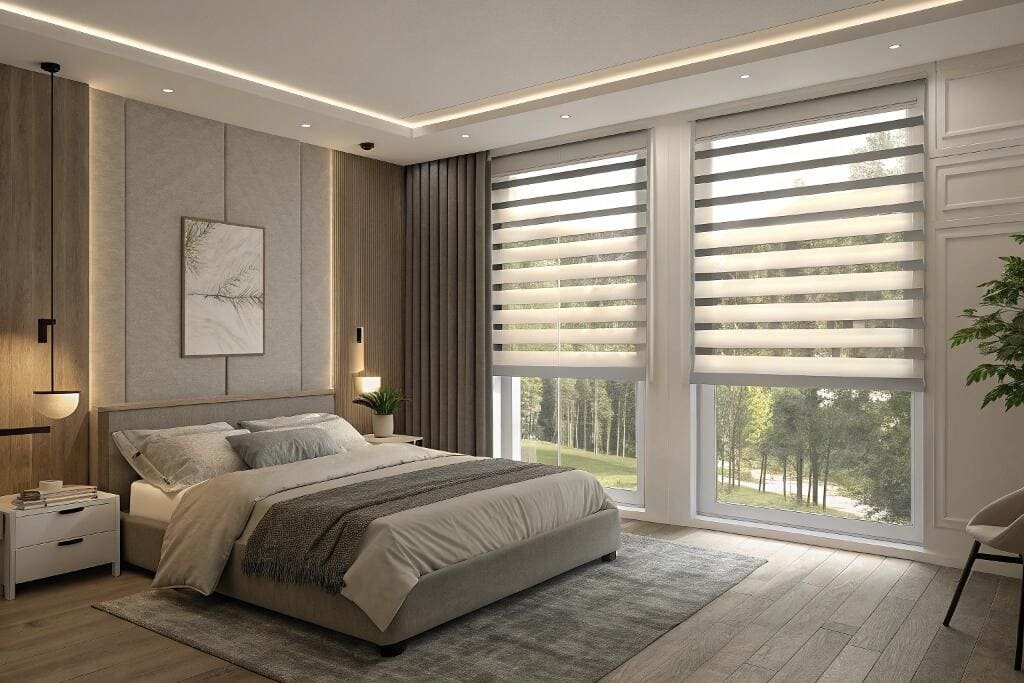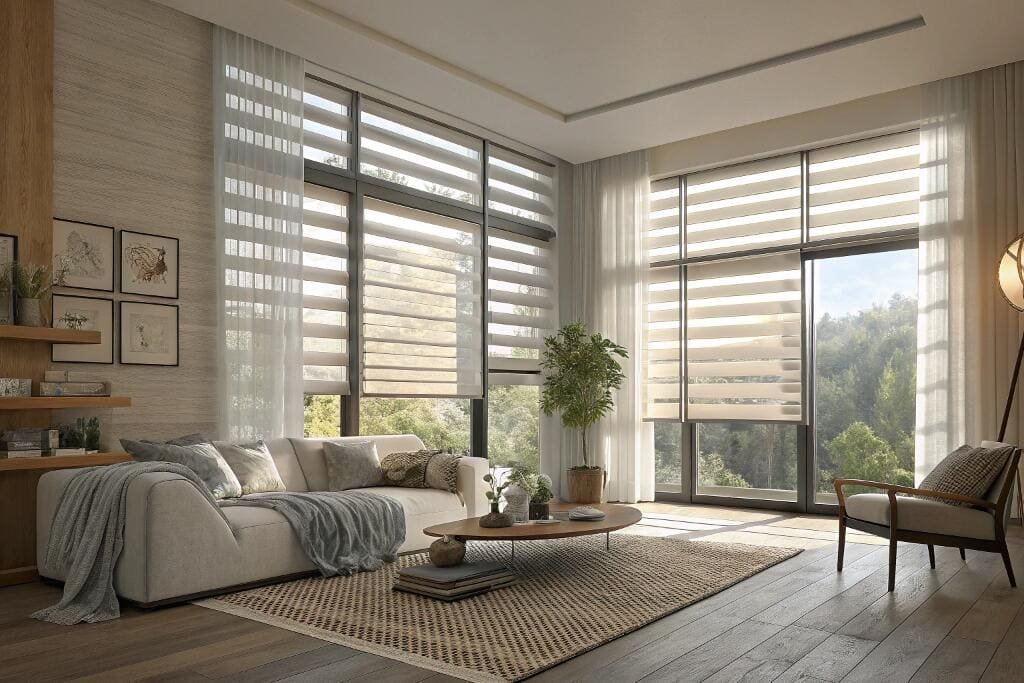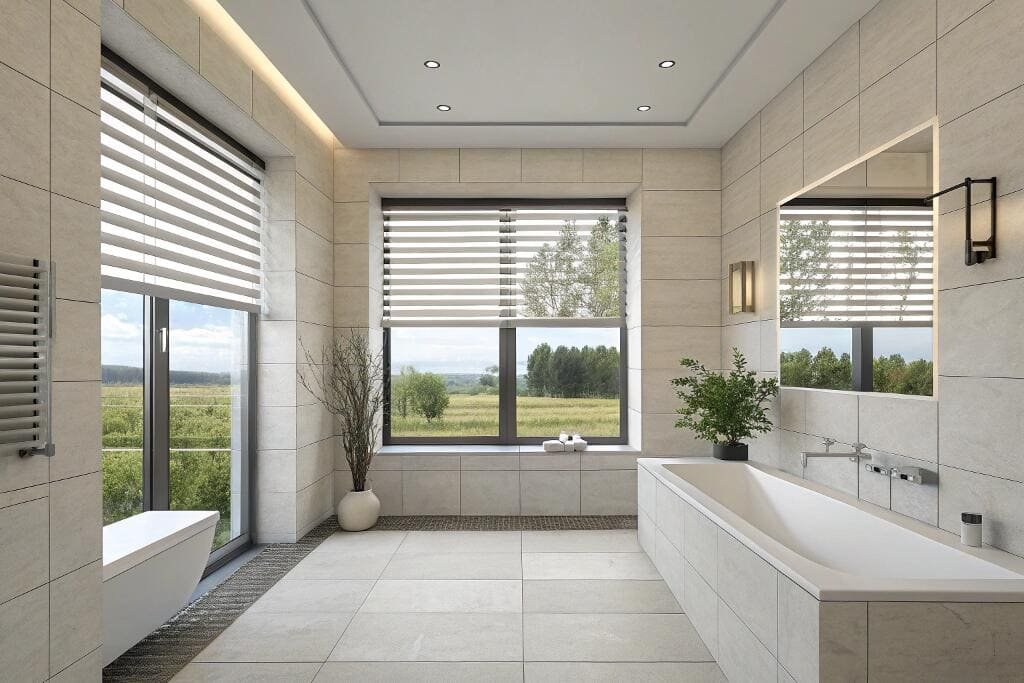Zebra blind materials confuse buyers struggling between polyester options and premium fabric choices. Understanding fabric composition determines both performance and longevity for your window treatment investment.
Zebra blinds are primarily made from polyester fabric with dual-layer construction featuring alternating sheer and solid fabric bands. Premium versions use 100% polyester with specialized weaving techniques that create the signature striped pattern for adjustable light control.

Modern zebra blinds represent sophisticated fabric engineering that balances functionality with aesthetic appeal. The material selection directly impacts light control[^1] effectiveness, durability, and maintenance requirements that determine long-term satisfaction with your window treatment choice.
What Material are Zebra Blinds Actually Made From?
Zebra blinds use specialized polyester fabric construction that creates their distinctive alternating pattern through precise weaving techniques. The dual-layer design combines transparency and opacity in a single fabric system.
Zebra blinds are constructed from 100% polyester fabric with dual-layer weaving that creates alternating transparent and opaque horizontal strips. This specialized fabric construction allows the characteristic light control functionality through overlapping fabric bands that can align or offset for variable opacity.

The polyester material selection for zebra blinds serves multiple technical purposes beyond basic functionality. Polyester provides dimensional stability that prevents fabric stretching or distortion during daily operation, ensuring the alternating strips maintain proper alignment for effective light control. The synthetic fiber construction offers superior color retention[^2] compared to natural materials, preventing fading that would compromise the visual contrast between sheer and solid fabric sections.
Manufacturing processes for zebra blind fabrics involve specialized looms that create the dual-density weaving pattern. Korean manufacturers have established industry leadership in zebra blind fabric production, with superior weaving quality that prevents the fabric fraying and separation issues common in lower-grade alternatives. The precision required for consistent stripe spacing and fabric tension makes quality control critical during the weaving process.
Fabric weight specifications typically range from 200-300 GSM for standard zebra blinds, providing sufficient opacity in solid sections while maintaining transparency in sheer areas. The fabric construction includes reinforced edges to prevent unraveling during cutting and installation, extending product lifespan through reduced maintenance requirements.
Chemical treatments applied to zebra blind fabrics include UV stabilizers that prevent degradation from sunlight exposure, antimicrobial coatings that resist mold and mildew growth, and flame retardant applications for commercial installations. These treatments enhance performance characteristics while maintaining the fabric's core light control functionality.
Are Zebra Blinds Good Quality Compared to Other Window Treatments?
Quality assessment of zebra blinds depends on manufacturing origin, fabric specifications, and hardware components that determine long-term performance. Korean-made zebra blinds consistently demonstrate superior quality compared to alternatives.
Korean-manufactured zebra blinds represent the highest quality standards in the category, with superior fabric weaving that prevents stripe separation and maintains dimensional stability[^3]. Quality indicators include precise stripe alignment, reinforced fabric edges, and smooth operation mechanisms that function reliably over extended use periods.
Quality evaluation criteria for zebra blinds encompass multiple technical specifications that affect both immediate performance and long-term durability. Fabric quality represents the primary differentiator, with premium zebra blinds featuring consistent weave density that creates uniform opacity levels across solid fabric sections while maintaining clarity in transparent areas.
Manufacturing quality control includes precise cutting techniques that prevent fabric fraying at edges, professional hemming that creates clean finished appearances, and accurate stripe spacing that ensures proper light control alignment. Lower quality alternatives often exhibit uneven stripe spacing, poor edge finishing, and fabric composition inconsistencies that compromise functionality.
Hardware quality significantly impacts overall blind performance, with premium systems featuring corrosion-resistant mounting brackets, smooth-operating chain mechanisms, and durable roller tubes that maintain fabric tension. Quality zebra blinds incorporate safety features including chain stops and tension devices that prevent operational hazards while ensuring consistent performance.
Testing protocols for quality zebra blinds include cycle testing that verifies operational durability through thousands of raise and lower cycles, UV exposure testing that confirms fabric stability under prolonged sunlight, and dimensional stability testing that ensures the blind maintains proper fit and function over time.
The price-quality relationship[^4] in zebra blinds reflects manufacturing complexity and material specifications, with premium options commanding higher prices due to superior fabric quality, precision manufacturing, and enhanced hardware components. Budget alternatives often compromise fabric quality or manufacturing precision, resulting in reduced lifespan and functionality issues.
Why Are Zebra Blinds So Expensive Compared to Standard Roller Shades?
Zebra blind pricing reflects complex manufacturing processes, specialized fabric construction, and precision engineering requirements that exceed standard roller shade production costs. The dual-layer fabric technology requires sophisticated weaving equipment and quality control procedures.
Zebra blinds cost more than standard roller shades due to specialized dual-layer fabric construction that requires precision weaving equipment and extensive quality control processes. The alternating opacity pattern demands exact stripe spacing and consistent fabric density that increases manufacturing complexity and material costs significantly.

The manufacturing cost structure for zebra blinds includes several premium components that justify higher pricing compared to conventional window treatments. Specialized weaving equipment capable of creating the dual-density fabric pattern represents significant capital investment for manufacturers, with setup costs requiring higher production volumes to achieve profitability.
Raw material costs for zebra blind fabric exceed standard polyester pricing due to specialized yarn specifications and weaving complexity. The dual-layer construction[^5] requires approximately 40% more material than equivalent single-layer fabrics, with additional processing steps that increase labor costs and production time. Quality control requirements for maintaining stripe alignment and fabric consistency add inspection costs that impact final pricing.
Research and development investments in zebra blind technology continue driving premium pricing, with manufacturers investing in improved weaving techniques, enhanced fabric treatments, and innovative control mechanisms. These development costs are amortized across product sales, contributing to higher unit prices compared to established roller shade technologies.
Market positioning also influences zebra blind pricing, with manufacturers targeting premium market segments that prioritize design innovation and advanced functionality over basic light control. The positioning strategy supports higher margins while funding continued product development and quality improvements.
Import and distribution costs for premium zebra blinds add significant markup due to specialized packaging requirements, careful handling protocols, and technical support needs. Korean manufacturers leading the quality segment require international shipping and customs processing that increase delivered costs compared to domestically produced alternatives.
How Long Do Zebra Blinds Last Under Normal Usage Conditions?
Zebra blind lifespan varies significantly based on fabric quality, manufacturing standards, and environmental conditions that affect wear patterns. Premium zebra blinds typically provide 5-10 years of reliable service with proper maintenance.
High-quality zebra blinds manufactured to commercial standards typically last 7-10 years under normal residential use, while premium Korean-made versions can exceed 10 years with proper maintenance. Lifespan depends primarily on fabric quality, operational frequency, and environmental exposure conditions including UV intensity and humidity levels.

The durability characteristics of zebra blinds depend on multiple interacting factors that determine functional lifespan and maintenance requirements. Fabric degradation represents the primary failure mode, with UV exposure causing gradual color fading and material weakening that eventually compromises opacity control and visual appearance.
Mechanical wear patterns focus on mounting hardware and chain mechanisms that experience stress during daily operation. Premium zebra blinds incorporate reinforced mounting points and corrosion-resistant hardware that extends operational life, while budget alternatives often exhibit premature failure in mounting brackets or chain mechanisms.
Environmental factors significantly impact zebra blind longevity, with high-humidity conditions promoting mold growth in fabric sections and extreme temperature variations causing fabric expansion and contraction that stresses seams and mounting points. Installation in direct sunlight accelerates UV degradation, while protected locations can extend lifespan significantly.
Usage patterns affect durability through operational frequency and adjustment range. Blinds operated multiple times daily experience greater mechanical wear than those adjusted seasonally, while full-range operations from completely closed to fully open create more stress than partial adjustments.
Maintenance practices directly influence lifespan through dust accumulation management, cleaning frequency, and hardware lubrication. Regular maintenance extends functional life by preventing fabric degradation and mechanical binding, while neglect accelerates wear patterns and reduces overall durability.
Quality indicators that predict extended lifespan include fabric weight specifications above 250 GSM, reinforced fabric edges with professional hemming, corrosion-resistant hardware with stainless steel components, and manufacturer warranty periods exceeding 2 years that indicate confidence in product durability.
What Are the Disadvantages of Zebra Blinds You Should Know?
Zebra blinds present several functional limitations that affect their suitability for specific applications and user preferences. Understanding these disadvantages helps make informed purchasing decisions.
Primary zebra blind disadvantages include incomplete light blocking due to fabric gaps, poor ventilation when closed, and dust accumulation in sheer fabric sections that complicates cleaning. The dual-layer design creates maintenance challenges and limits complete privacy compared to solid blind alternatives.

Light leakage represents the most significant functional limitation of zebra blinds, with inherent gaps between solid and sheer fabric sections preventing complete blackout conditions. Even when positioned for maximum opacity, light infiltration occurs through fabric spacing and mounting hardware gaps, making zebra blinds unsuitable for environments requiring total darkness.
Ventilation performance issues stem from the dual-layer fabric construction that restricts airflow when blinds are lowered. While sheer sections appear to permit air circulation, the overlapping fabric layers significantly reduce ventilation effectiveness compared to traditional venetian blinds or open windows, requiring blind raising for adequate air circulation.
Maintenance complexity increases with zebra blinds due to dust accumulation in sheer fabric sections that requires careful cleaning techniques. Static electricity generated by synthetic fabrics attracts and holds dust particles, while the alternating fabric pattern complicates thorough cleaning compared to smooth roller shade surfaces.
Size limitations affect large window applications, with zebra blinds experiencing fabric sagging and operational difficulties when exceeding optimal width specifications. Oversized installations require dividing windows into multiple blind sections, creating visible seams that compromise aesthetic continuity.
Noise generation during operation can be problematic in quiet environments, with chain mechanisms and fabric movement creating operational sounds that may disturb sleeping areas or concentrate work spaces. The bottom rail weight also creates impact noise when blinds contact window sills or walls during wind movement.
Cost considerations extend beyond initial purchase to include specialized cleaning requirements and potential repair complexity that increases long-term ownership costs compared to simpler window treatment alternatives.
Are Zebra Shades Outdated or Still Contemporary?
Zebra shades maintain contemporary relevance through continued design evolution and modern aesthetic appeal that aligns with current interior design trends. Their popularity has grown consistently since introduction from Korea in 2005.
Zebra shades remain contemporary and increasingly popular due to their modern aesthetic that complements minimalist interior design trends. The clean lines and sophisticated light control functionality align perfectly with current architectural preferences for functional design elements that enhance rather than dominate interior spaces.

The contemporary appeal of zebra blinds stems from their alignment with current interior design preferences emphasizing clean lines, functional aesthetics, and space efficiency. Modern architecture favors window treatments that provide sophisticated functionality without visual clutter, making zebra blinds ideal for contemporary residential and commercial applications.
Design evolution continues advancing zebra blind aesthetics through expanded color palettes, texture variations, and hardware refinements that maintain relevance with changing interior trends. Manufacturers regularly introduce new fabric options and control mechanisms that keep the product category current with market demands.
Smart home integration capabilities position zebra blinds at the forefront of home automation trends, with motorized versions supporting smartphone control and integration with voice assistants. These technological enhancements ensure continued relevance as homes become increasingly connected and automated.
Professional interior designers frequently specify zebra blinds for modern projects due to their versatility and sophisticated appearance that complements various design styles from minimalist to transitional. The product's ability to provide precise light control while maintaining visual elegance makes it suitable for high-end residential and commercial installations.
Market growth data indicates increasing zebra blind adoption, with sales growth consistently outpacing traditional blind categories. This market expansion demonstrates continued consumer acceptance and preference for the unique functionality and aesthetic appeal that zebra blinds provide.
Can You See Through Zebra Blinds at Night When Lights Are On?
Night visibility through zebra blinds depends on interior lighting conditions and fabric opacity specifications. Internal illumination can create silhouette visibility that compromises privacy expectations.
Interior lighting creates silhouette visibility through zebra blinds at night, particularly when positioned for partial transparency. The sheer fabric sections become translucent when backlit, allowing observers outside to see shadows and general activity inside, which reduces privacy protection compared to solid window treatments.

The physics of light transmission through zebra blind fabrics creates privacy vulnerabilities during evening hours when interior spaces are illuminated. Light sources inside rooms pass through sheer fabric sections with minimal diffusion, creating clearly visible silhouettes that reveal occupant activities and room layouts to external observers.
Positioning adjustments can partially address night visibility concerns by aligning solid fabric sections to maximize opacity, but complete privacy elimination requires supplemental window treatments or strategic interior lighting management. Room lighting positioned away from windows reduces silhouette creation, while ambient lighting provides functional illumination without compromising privacy.
Security implications of night visibility include potential observation of valuable items, occupancy patterns, and daily routines that could attract unwanted attention. Properties with high security requirements should consider zebra blind privacy limitations when evaluating window treatment options for ground-floor or easily accessible windows.
Solution strategies for night privacy concerns include dual window treatment systems combining zebra blinds with privacy curtains, strategic interior lighting placement that minimizes backlit silhouettes, and timer-controlled lighting systems that manage illumination patterns during evening hours.
Fabric selection impacts night visibility, with heavier weight fabrics and tighter weave patterns reducing transparency compared to lightweight alternatives. However, the fundamental dual-layer design creates inherent visibility that cannot be completely eliminated through fabric selection alone.
Conclusion
Zebra blind materials center on polyester fabric construction with dual-layer weaving that creates the signature alternating opacity pattern for sophisticated light control functionality.
Extended FAQ Section
What fabric weight provides the best performance for zebra blinds?
Zebra blinds with fabric weights between 250-300 GSM offer optimal performance balancing light control effectiveness with operational durability. Heavier fabrics provide better opacity in solid sections while maintaining dimensional stability, though weights below 200 GSM often result in inadequate light blocking and premature wear.
Fabric weight specifications directly influence zebra blind performance through opacity control, dimensional stability, and operational longevity. Lighter weight fabrics below 200 GSM often exhibit inadequate opacity in solid sections, allowing excessive light transmission that compromises the primary light control function.
The relationship between fabric weight and performance extends to operational characteristics, with appropriate weight providing sufficient body to maintain stripe alignment while preventing excessive bulk that impedes smooth operation. Fabrics in the 250-300 GSM range demonstrate optimal balance between functionality and operational ease.
Manufacturing considerations for fabric weight include weaving complexity and material costs that increase with heavier specifications. However, the performance benefits of appropriate fabric weight justify higher material costs through extended product lifespan and superior functionality.
Quality manufacturers specify fabric weight ranges that ensure consistent performance across production runs, with tolerance controls that maintain uniform characteristics throughout large installations requiring multiple blind units.
How do different polyester weaving techniques affect zebra blind quality?
**Advanced polyester weaving techniques using specialized jacquard looms create more precise stripe patterns and improved fabric stability compared to basic weaving methods. Korean manufacturers utilize sophisticated weaving equipment that produces superior stripe definition and prevents fabric separation common in lower quality alternatives.
Jacquard weaving technology enables precise control over fabric density variations that create the alternating opacity pattern characteristic of high-quality zebra blinds. The sophisticated loom programming ensures consistent stripe spacing and fabric tension that prevents the alignment issues common in products manufactured with basic weaving equipment.
The technical advantages of advanced weaving include reinforced fabric transitions between sheer and solid sections that prevent separation stress points. Quality manufacturers use specialized threading techniques that secure fabric transitions, preventing the stripe separation that commonly occurs in lower-grade products after extended use.
Manufacturing precision in weaving affects long-term product performance through dimensional stability and operational consistency. Advanced weaving techniques produce fabrics with uniform stretch characteristics that maintain proper alignment during temperature variations and humidity changes that would distort inferior products.
Do zebra blinds require special cleaning methods compared to other window treatments?
Zebra blinds require gentle cleaning methods due to their dual-layer fabric construction and alternating density patterns that can trap dust and debris more readily than smooth roller shade surfaces. Regular vacuuming with brush attachments and spot cleaning with mild detergent solutions provide optimal maintenance without damaging the specialized fabric structure.
The cleaning challenges with zebra blinds stem from static electricity generated by polyester fabrics that attracts and holds dust particles, particularly in the sheer fabric sections where particles become visible against light backgrounds. Traditional cleaning methods used for solid fabrics can damage the delicate weave pattern in transparent sections.
Vacuuming techniques for zebra blinds require low suction settings with soft brush attachments to avoid fabric damage while removing surface dust and debris. The alternating fabric pattern requires careful attention to ensure thorough cleaning without missing accumulated particles in transition areas between solid and sheer sections.
Spot cleaning protocols for zebra blinds involve diluted mild detergent solutions applied with soft cloths, working in gentle circular motions to avoid fabric distortion. The dual-layer construction requires careful moisture control to prevent trapped water that could promote mold growth between fabric layers.
Professional cleaning services offer specialized zebra blind cleaning that addresses the unique challenges of dual-layer fabric construction while maintaining fabric integrity and appearance. These services use ultrasonic cleaning techniques and controlled drying processes that preserve fabric characteristics while achieving thorough soil removal.
What installation considerations affect zebra blind performance and longevity?
Proper zebra blind installation requires precise measurements, adequate mounting hardware, and correct tension adjustment to ensure optimal performance and extended product life. Installation errors including inadequate bracket support and improper fabric tension commonly cause premature failure and operational problems.
Installation precision directly impacts zebra blind performance through proper fabric alignment and mounting stability. Measurements must account for both inside and outside mount options, with inside mounting requiring precise width calculations that prevent fabric binding against window frames during operation.
Mounting hardware specifications must support the combined weight of fabric, roller mechanisms, and operational stresses without deflection that could cause alignment problems. Inadequate bracket support commonly leads to sagging that prevents proper stripe alignment and compromises light control functionality.
Fabric tension adjustment during installation ensures proper operation and prevents premature wear from excessive slack or over-tensioning. Correct tension maintains stripe alignment while allowing smooth operation without binding or resistance that could damage mechanisms or fabric.
Level installation requirements for zebra blinds exceed standard roller shade tolerances due to the precision needed for proper stripe alignment. Even minor installation angles can cause fabric misalignment that prevents optimal light control and creates uneven wear patterns that reduce product lifespan.
Get Professional Zebra Blind Solutions for Your Project
Understanding zebra blind materials helps you make informed decisions, but selecting the right specifications and ensuring proper installation requires professional expertise. I help distributors and contractors source premium zebra blinds with detailed technical specifications that eliminate guesswork from your projects.
My experience with Korean manufacturers and quality control processes ensures you receive zebra blinds that meet professional standards for durability and performance. I provide complete technical documentation, installation guidelines, and ongoing support that keeps your projects on schedule and within budget.
Whether you need zebra blinds for residential developments or commercial installations, I deliver solutions with verified material specifications, quality certifications, and competitive pricing that supports your business growth and client satisfaction.
Stop dealing with quality issues and specification uncertainties that compromise your projects. Get expert guidance and premium zebra blind solutions tailored to your specific requirements and market demands.
info@velablinds.com
---
[^1]: Discover the innovative design that allows for customizable light filtering.
[^2]: Understand the importance of color retention for maintaining aesthetic appeal.
[^3]: Learn how dimensional stability affects the performance of window treatments.
[^4]: Discover how pricing reflects the quality and features of zebra blinds.
[^5]: Understand how dual-layer construction enhances light control and aesthetics.Partner with VelaBlinds for Your Next Project
Smart window treatments shouldn't be complicated. After working with 500+ distributors and contractors worldwide, I've streamlined the process to get you quality products, competitive pricing, and reliable support - every time.
Why project professionals choose VelaBlinds:
- ✅ Fast, Accurate Quotes - Detailed specs and pricing within 24 hours
- ✅ Transparent Pricing - No hidden fees, volume discounts clearly outlined
- ✅ Quality Assurance - Direct partnerships with certified OEM manufacturers
- ✅ Project Support - Dedicated account manager from quote to delivery
Start your next project:
📧 Quick Quote: Send your requirements to info@velablinds.com
📱 Direct Contact: WhatsApp +86 137 2012 8317
🌐 Browse Solutions: https://velablinds.com/
📁 Product Resources: Access spec sheets, catalogs & project files
Jimmy Chen, Founder
"I built VelaBlinds to solve the real challenges I faced as a project buyer - long lead times, unclear specs, and unreliable suppliers. Let's discuss how we can power your projects with smarter blinds."
Serving distributors and contractors across North America, Europe, and Australia since 2018.




